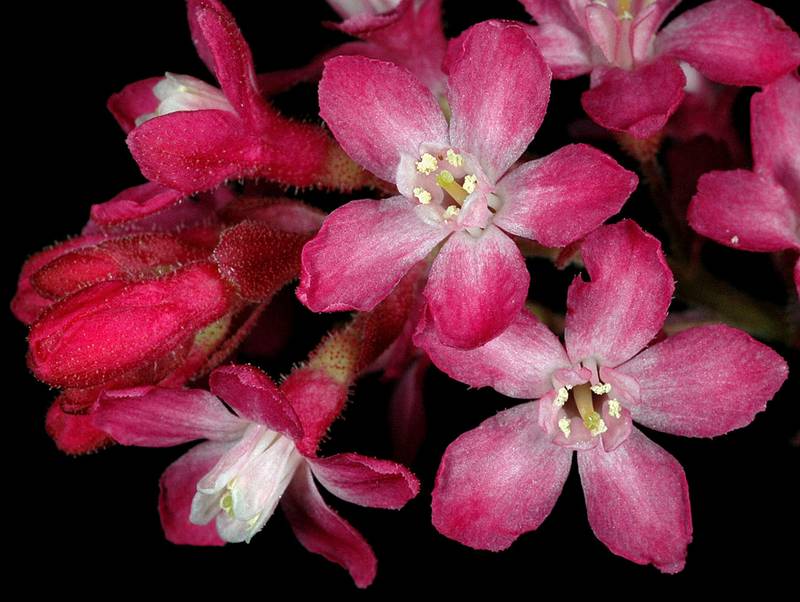Ribes sanguineum
Ribes aureum
blood currant, red currant, red flowering currant
golden currant
Leaves alternate, petiolate, broadly reniform to deltoid-ovate, 2.5-6 cm. broad, the lower surface much paler and hairier than the upper, palmately 5-lobed, the lobes deltoid to rounded and finely denticulate.
Leaves alternate, petiolate, pale green, the blades broadly deltoid-ovate to ovate, 2-5 cm. broad, palmately 3-lobed less than half their length, the segments entire or with 2-5 rounded teeth.
Inflorescence of erect, 10- to 20-flowered racemes;
pedicels jointed;
calyx pale to deep rose, finely pubescent;
calyx tube 3-5 mm. long and nearly a broad, the 5 lobes oblong, equal to the tube, spreading;
petals 5, white to light rose, obovate-spatulate, entire, 2.5-3.5 mm. long;
stamens 5, equaling the petals, the filaments pinkish;
styles 2, glabrous, fused almost to the stigmas;
ovary inferior.
Flowers fragrant, 5-18 in ascending or reflexed racemes usually longer than the leaves;
pedicels up to 8 mm. long;
calyx tube cylindric, 6-8 mm. long, the 5 lobes oblong-elliptic, spreading, 5-7 mm. long, the lobes and tube golden yellow;
petals 5, small, yellow to reddish, oblong-obovate, erect;
stamens 5, alternate with and equal to the petals;
styles 2, fused almost to the stigmas, glabrous, about equal to the calyx lobes;
ovary inferior.
Berry globose, 7-9 mm. long, glaucous-black.
Berry globose, glabrous, about 7 mm. long, orange or occasionally burgundy.
Ribes sanguineum
Ribes aureum
- Local floras:
BC,
CA,
OR,
WA
- Local Web sites:
CalFlora,
CalPhotos,
Flora NW,
PNW Herbaria,
Turner Photog.
WildflowerSearch
iNaturalist (observations)
USDA Plants Database
- LBJ Wildflower Center
- SEINet
- Plants of the World Online
- Encyclopedia of Life
- Wikipedia
- Google Image Search
- Local floras:
BC,
CA,
OR,
WA
- Local Web sites:
CalFlora,
CalPhotos,
Flora NW,
PNW Herbaria,
Turner Photog.
WildflowerSearch
iNaturalist (observations)
USDA Plants Database
- LBJ Wildflower Center
- SEINet
- Plants of the World Online
- Encyclopedia of Life
- Wikipedia
- Google Image Search



